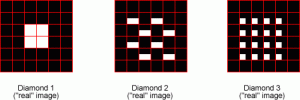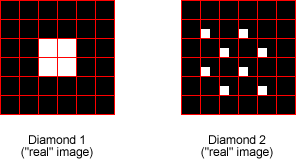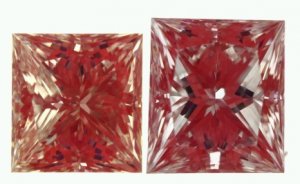Superidealist
Brilliant_Rock
- Joined
- Sep 10, 2003
- Messages
- 655
Introduction
The BrillianceScope scores "white light," "color light," and "scintillation" according to the following scheme:
The images are made up of thousands of "pixels". The analysis program then examines each pixel and determines if it is a White pixel, Color pixel or other. The software then counts the number of White pixels in all five images and divides it by the total number of pixels in the diamond. Thus a percentage number is arrived at i.e. the White Light Performance (WLP).
We measured thousands of diamonds to find the best WLP and the worst WLP. A simple linear scale was developed with the worst WLP on the left and the best WLP on the right. The software then plots the WLP number of the measured diamond on the scale. This allows anyone at a glance to determine how this diamond compares to others in the world.
The exact procedure and steps apply to the Color Light Performance. Scintillation is slightly different in that the number of "points of Light" that turn on and off as the lighting changes is plotted on the graphs. (Source: www.gemex.com/htmdocs/consumer/old/technical_faqs.html, now inactive)
In short, each measure ("white light," "color light," and "scintillation") is determined by first classifying pixels as white, color, or other, then counting them, and finally assigning a score based on this count.
Summary
Each pixel is classified as either white, color, or other according to an undisclosed rule chosen by GemEx. The choice of classification rules influences the scores generated. Three claims are made regarding this:
• Different classification rules can lead to different pixel counts for the exact same image.
• BrillianceScope scores of diamonds with different characteristics can differ based on the rule chosen to classify pixels even if the total area covered by the flashes is exactly the same.
• The choice of rule used to classify pixels can result in the BrillianceScope favoring diamonds with certain characteristics over other better-performing diamonds.
The Problem
As stated by GemEx above, each pixel in an image is classified as either white, color, or other. Some rule is used to make this assignment, but the specifics of this rule have not been made public. We will show that different classification rules lead to different pixel counts for the same image and to different rankings for diamonds having different characteristics - even to the extent that diamonds favored by the chosen rule can outscore other better-performing diamonds.
To simplify, let us confine our attention to the "white light" scale. (Similar arguments apply to "color light" and "scintillation.") Furthermore, in the interest of clarity, we consider only the case where the image is strictly black and white. (Rules for color images are necessarily more complex but the principles outlined still apply.)
Consider the three classification rules listed below.
Rule A: A pixel is classified as a "white" pixel if and only if it is 100% white.
Rule B: A pixel is classified as a "white" pixel if and only if it is at least 50% white.
Rule C: A pixel is classified as a "white" pixel if and only if it is at least 25% white.
Consider the simplified diamond image shown below. Under Rule A, this image contains exactly one white pixel. Under Rule B, this image contains exactly five white pixels. Under Rule C, this image contains exactly nine white pixels. So, as claimed, different classification rules can lead to different pixel counts for the exact same image.

The BrillianceScope scores "white light," "color light," and "scintillation" according to the following scheme:
The images are made up of thousands of "pixels". The analysis program then examines each pixel and determines if it is a White pixel, Color pixel or other. The software then counts the number of White pixels in all five images and divides it by the total number of pixels in the diamond. Thus a percentage number is arrived at i.e. the White Light Performance (WLP).
We measured thousands of diamonds to find the best WLP and the worst WLP. A simple linear scale was developed with the worst WLP on the left and the best WLP on the right. The software then plots the WLP number of the measured diamond on the scale. This allows anyone at a glance to determine how this diamond compares to others in the world.
The exact procedure and steps apply to the Color Light Performance. Scintillation is slightly different in that the number of "points of Light" that turn on and off as the lighting changes is plotted on the graphs. (Source: www.gemex.com/htmdocs/consumer/old/technical_faqs.html, now inactive)
In short, each measure ("white light," "color light," and "scintillation") is determined by first classifying pixels as white, color, or other, then counting them, and finally assigning a score based on this count.
Summary
Each pixel is classified as either white, color, or other according to an undisclosed rule chosen by GemEx. The choice of classification rules influences the scores generated. Three claims are made regarding this:
• Different classification rules can lead to different pixel counts for the exact same image.
• BrillianceScope scores of diamonds with different characteristics can differ based on the rule chosen to classify pixels even if the total area covered by the flashes is exactly the same.
• The choice of rule used to classify pixels can result in the BrillianceScope favoring diamonds with certain characteristics over other better-performing diamonds.
The Problem
As stated by GemEx above, each pixel in an image is classified as either white, color, or other. Some rule is used to make this assignment, but the specifics of this rule have not been made public. We will show that different classification rules lead to different pixel counts for the same image and to different rankings for diamonds having different characteristics - even to the extent that diamonds favored by the chosen rule can outscore other better-performing diamonds.
To simplify, let us confine our attention to the "white light" scale. (Similar arguments apply to "color light" and "scintillation.") Furthermore, in the interest of clarity, we consider only the case where the image is strictly black and white. (Rules for color images are necessarily more complex but the principles outlined still apply.)
Consider the three classification rules listed below.
Rule A: A pixel is classified as a "white" pixel if and only if it is 100% white.
Rule B: A pixel is classified as a "white" pixel if and only if it is at least 50% white.
Rule C: A pixel is classified as a "white" pixel if and only if it is at least 25% white.
Consider the simplified diamond image shown below. Under Rule A, this image contains exactly one white pixel. Under Rule B, this image contains exactly five white pixels. Under Rule C, this image contains exactly nine white pixels. So, as claimed, different classification rules can lead to different pixel counts for the exact same image.
















300x240.png)